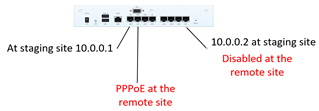Hello,
So I'm looking to setup PPPoE on eth0 for a remote site. While I have it at the main site I have connected eth0 and eth7, assigned both a different IP, and can log into either IP to get to the management webpage. However when I disconnect eth1 I can no longer get to the assigned IP setup for eth7. I want to configure eth1 for the remote site's PPPoE, but I'm just not seeing how that's possible. As I can get to the IP for eth7 when eth0 is connected I feel like I have the firewalls and connection setup correctly, but for some reason pulling the cable out of eth0 removes the ability to use eth7. Any suggestions?
Thanks,
Mark
PS does anyone have a better article than this - https://community.sophos.com/kb/en-us/119003 for setting up PPPoE?
This thread was automatically locked due to age.



